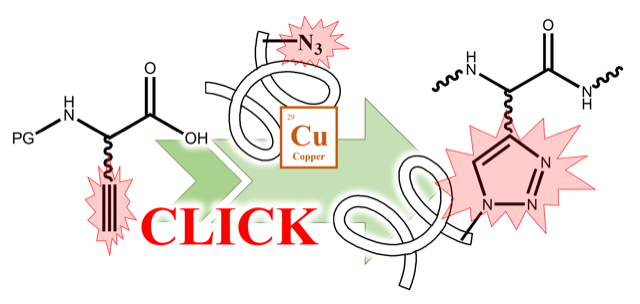Welcome to Iris Biotech
For better service please confirm your country and language we detected.

For better service please confirm your country and language we detected.

Thank you very much for your interest in our products. All prices listed on our website are ex-works, Germany, and may attract customs duties when imported.
You may/will be contacted by the shipping company for additional documentation that may be required by the US Customs for clearance.
We offer you the convenience of buying through a local partner, Peptide Solutions LLC who can import the shipment as well as prepay the customs duties and brokerage on your behalf and provide the convenience of a domestic sale.
Continue to Iris Biotech GmbHSend request to US distributorChemischer Name: (S)-Amino-6-((prop-2-ynyloxy)carbonylamino)hexanoic acid hydrochloride // Synonyme: N-epsilon-(Prop-2-ynyloxycarbonyl)-L-lysine hydrochloride, H-L-Lys(Pryoc)-OH*HCl , H-Lys(Poc)-OH*HCl, ProK, PrK
Startet von 70,00 €
H-L-Lys(Pryoc)-OH or H-L-Lys(EO-N3)-OH (HAA2080) are non-canonical amino acids suitable for click chemistry. They can be introduced site-specifically into recombinant proteins by the Pyrrolysyl-tRNA Synthetase/tRNA(CUA) Pair. Pyrrolysine (Pyl; HAA2830) is considered the 22nd proteinogenic amino acid. It is a naturally occurring, genetically coded amino acid used by some methanogenic archaea and one known bacterium in enzymes that are part of their methane-producing metabolism. It is similar to lysine, but with an added pyrroline ring linked to the end of the lysine side chain. It forms part of an unusual genetic code in these organisms.
Propargyloxycarbonyl, commonly abbreviated as Poc or Pryoc, can either be used as alkyne component for standard Click conjugation or in combination with tetrazine linkers in copper-free Diels-Alder type Click reactions. It also has applications as unusual protecting group for amines, hydroxy functions and as esters. All 3 are stable to neat TFA, but can be cleaved at ambient temperature with Co2(CO)8 in TFA:DCM. Deprotection with other transition metals like palladium have also been reported.
H-Lys(Poc)-OH is incorporated into proteins as an unnatural amino acid for further modifications using Click-chemistry.
Small Unnatural Amino Acid Carried Raman Tag for Molecular Imaging of Genetically Targeted Proteins; J. Zhang, S. Yan, Z. He, C. Ding, T. Zhai, Y. Chen, H. Li, G. Yang, X. Zhou and P. Wang; J Phys Chem Lett 2018; 9: 4679-4685. https://doi.org/10.1021/acs.jpclett.8b01991
Bioorthogonal Catalysis: A General Method To Evaluate Metal-Catalyzed Reactions in Real Time in Living Systems Using a Cellular Luciferase Reporter System; H. T. Hsu, B. M. Trantow, R. M. Waymouth and P. A. Wender; Bioconjug Chem 2016; 27: 376-82. https://doi.org/10.1021/acs.bioconjchem.5b00469
N-alkynyl derivatives of 5-fluorouracil: susceptibility to palladium-mediated dealkylation and toxigenicity in cancer cell culture; J. T. Weiss, C. Fraser, B. Rubio-Ruiz, S. H. Myers, R. Crispin, J. C. Dawson, V. G. Brunton, E. E. Patton, N. O. Carragher and A. Unciti-Broceta; Front Chem 2014; 2: 56. https://doi.org/10.3389/fchem.2014.00056
Palladium-triggered deprotection chemistry for protein activation in living cells; J. Li, J. Yu, J. Zhao, J. Wang, S. Zheng, S. Lin, L. Chen, M. Yang, S. Jia, X. Zhang and P. R. Chen; Nat Chem 2014; 6: 352-61. https://doi.org/10.1038/nchem.1887
Palladium-triggered deprotection chemistry for protein activation in living cells; J. Li, J. Yu, J. Zhao, J. Wang, S. Zheng, S. Lin, L. Chen, M. Yang, S. Jia, X. Zhang and P. R. Chen; Nat Chem 2014; 6: 352-61. https://doi.org/10.1038/nchem.1887
Click strategies for single-molecule protein fluorescence; S. Milles, S. Tyagi, N. Banterle, C. Koehler, V. VanDelinder, T. Plass, A. P. Neal and E. A. Lemke; J Am Chem Soc 2012; 134: 5187-95. https://doi.org/10.1021/ja210587q
Genetic encoding of a bicyclo[6.1.0]nonyne-charged amino acid enables fast cellular protein imaging by metal-free ligation; A. Borrmann, S. Milles, T. Plass, J. Dommerholt, J. M. Verkade, M. Wiessler, C. Schultz, J. C. van Hest, F. L. van Delft and E. A. Lemke; Chembiochem : a European journal of chemical biology 2012; 13: 2094-9. https://doi.org/10.1002/cbic.201200407
Expanding the genetic code of Drosophila melanogaster; A. Bianco, F. M. Townsley, S. Greiss, K. Lang and J. W. Chin; Nat Chem Biol 2012; 8: 748-50. https://doi.org/10.1038/nchembio.1043
Expanding the genetic code of an animal; S. Greiss and J. W. Chin; J Am Chem Soc 2011; 133: 14196-9. https://doi.org/10.1021/ja2054034
Encoding multiple unnatural amino acids via evolution of a quadruplet-decoding ribosome; H. Neumann, K. Wang, L. Davis, M. Garcia-Alai and J. W. Chin; Nature 2010; 464: 441-4. https://doi.org/10.1038/nature08817
A facile system for genetic incorporation of two different noncanonical amino acids into one protein in Escherichia coli; W. Wan, Y. Huang, Z. Wang, W. K. Russell, P. J. Pai, D. H. Russell and W. R. Liu; Angew Chem Int Ed Engl 2010; 49: 3211-4. https://doi.org/10.1002/anie.201000465
Expanding the genetic code of yeast for incorporation of diverse unnatural amino acids via a pyrrolysyl-tRNA synthetase/tRNA pair; S. M. Hancock, R. Uprety, A. Deiters and J. W. Chin; J Am Chem Soc 2010; 132: 14819-24. https://doi.org/10.1021/ja104609m
Genetic encoding and labeling of aliphatic azides and alkynes in recombinant proteins via a pyrrolysyl-tRNA Synthetase/tRNA(CUA) pair and click chemistry; D. P. Nguyen, H. Lusic, H. Neumann, P. B. Kapadnis, A. Deiters and J. W. Chin; J Am Chem Soc 2009; 131: 8720-1. https://doi.org/10.1021/ja900553w
Direct charging of tRNACUA with pyrrolysine in vitro and in vivo; S. K. Blight, R. C. Larue, A. Mahapatra, D. G. Longstaff, E. Chang, G. Zhao, P. T. Kang, K. B. Green-Church, M. K. Chan and J. A. Krzycki; Nature 2004; 431: 333. https://doi.org/10.1038/nature02895
Pyrrolysine encoded by UAG in Archaea: charging of a UAG-decoding specialized tRNA; G. Srinivasan, C. M. James and J. A. Krzycki; Science 2002; 296: 1459-62. https://doi.org/10.1126/science.1069588
A new UAG-encoded residue in the structure of a methanogen methyltransferase; B. Hao, W. Gong, T. K. Ferguson, C. M. James, J. A. Krzycki and M. K. Chan; Science 2002; 296: 1462-6. https://doi.org/10.1126/science.1069556
Propargyloxycarbonyl and propargyl groups for novel protection of amino, hydroxy, and carboxy functions; Y. Fukase, K. Fukase and S. Kusumoto; Tetrahedron Letters 1999; 40: 1169-1170. https://doi.org/10.1016/s0040-4039(98)02555-6
Sie benötigen größere Mengen für Ihre Entwicklung oder Produktion?
Bitte senden Sie mir mehr Informationen über








